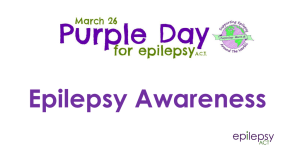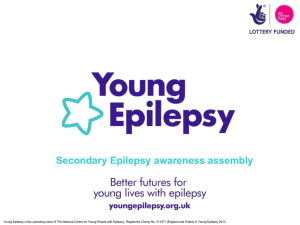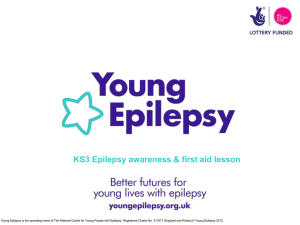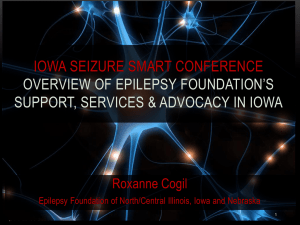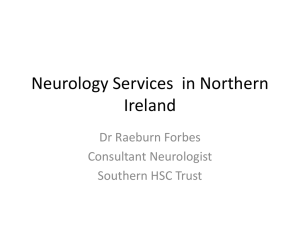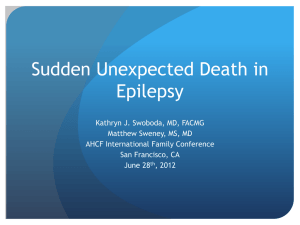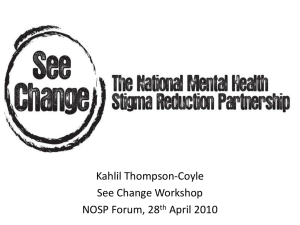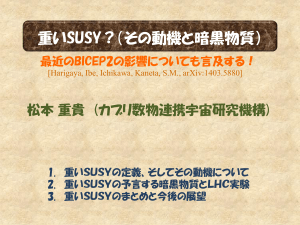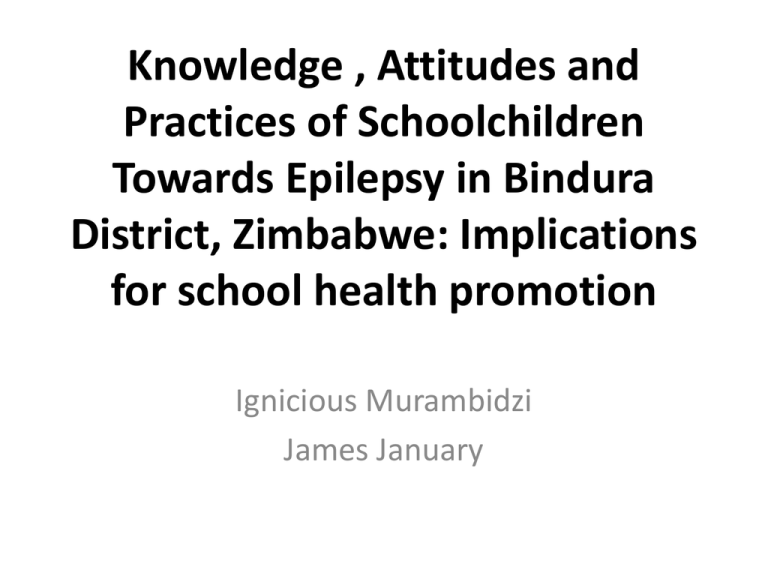
Knowledge , Attitudes and
Practices of Schoolchildren
Towards Epilepsy in Bindura
District, Zimbabwe: Implications
for school health promotion
Ignicious Murambidzi
James January
Introduction
• Epilepsy represents a considerable public health
affecting about 50 million people globally with more
than 80% living in developing countries (de Boer, Mula
& Sander, 2007)
• Treatment gaps for active epilepsy exceeded 75% in
most low-income countries and less than 10% in high
income countries (Meyer, Dua, Ma, Saxena & Birbeck
2010)
• Different perceptions and understanding of epilepsy,
lack of prioritization, poor medical supply chain, lack of
knowledge on epilepsy, stigma and discrimination all
contribute to treatment gaps (ILAE,IBE, WHO 2003;
Scott, Lhatoo & Sander, 2001)
Introduction
• Social stigma and discrimination was reported
to be more devastating for persons with
epilepsy than the seizures themselves (De
Boer, Mula & Sander, 2008)
• Widespread attitudinal and institutional
barriers and prejudices against PWE in
education, employment, marriage and other
socio economic activities (Atadzhanov et al ,
2010)
Introduction
• KAP studies on epilepsy among teachers
noted that teachers lack basic first aid
knowledge on seizure management (Mielke,
et al. 1997; Birbeck, et al. 2006; Sanya,et al
2005)
• Studies on adolescents reported little
knowledge about epilepsy and seizures, and
perceptions that reflected stigma (MacLeod,
& Austin,2003; Austin, Shafer, Deering, 2002)
•
Study Rationale
• The Demonstration Project on Epilepsy in
Zimbabwe reported high community
prevalence of epilepsy of 13.3/1000 and wide
treatment gap 93% (ILAE,IBE WHO, 2003)
• Poor understanding of epilepsy, beliefs in
supernatural causes, stigma and
discrimination notably contributed to the
delay in seeking treatment, underutilization of
formal health services.
Rationale
• The study sought to contribute to the
knowledge base on community’s perception,
attitudes, and practices on epilepsy
• Study focused on schoolchildren - reflect
their communities’ present and future
characteristics.
• look forward to developing culturally sensitive
and effective educational materials targeting
children as social change agents
Study purpose
Aim - obtain baseline data on the knowledge,
attitudes and practices of schoolchildren with
respect to epilepsy
Objectives
• To assess school children’s knowledge of
epilepsy
• To describe the attitudes and practices of school
children with respect to epilepsy.
• To discuss the implications of the prevailing
knowledge levels, attitudes and practices on the
education and management of epilepsy in
Zimbabwe.
Methods
• A total of 523 school going children from three
secondary schools in Bindura District
Mashonaland Central Province, Zimbabwe
• Multi-stage sampling was adopted
• The subjects responded to a self administered
questionnaire in either English or Shona (local
translation) language.
• 14-item questionnaire was adapted from a study
among secondary school children Cameroon, in
2010 (Njamnshi et al, 2010)
• Medical Research Council of Zimbabwe (IRB)
reviewed and approved the study
Results
Sex
229 females
282 males
Age
127 (12-14 yrs) 262 (15-17yrs) 124 (18yrs)
Mean age 16 years (sd 2)
Level
202 (F 1-2)
Location 174 (Rural)
226 (F 3-4)
69 (F 5-6)
218 (urban)
131 (CFA )
Results
Familiarity with epilepsy
• About 87% had heard about epilepsy.
• The primary source of information were friends
and school (54.7% and 51.4% respectively).
• Up to 63% knew someone with epilepsy while
55.04% had witnessed a seizure.
• Participants from rural and commercial farming
areas were likely to know someone with epilepsy
or had witnessed a seizure (P = 0.001)
Results
Knowledge about epilepsy
• There was patchy information on the causes
of epilepsy with 28% correctly identifying
epilepsy as a brain disorder
• 26% reported not knowing the causes of
epilepsy.
• A number of misconceptions were reported
on the causes of epilepsy which included,
blood disorder (29%), witchcraft (18%).
• No significant differences between knowledge
and age, school location and religion
Results
Practices
• On epilepsy first aid, 47% would call for help, 46%
would take the person away from danger, 34 %
would put something soft under the head for
protection
• However harmful practices were also common
with 17% reporting putting a spoon or cloth in
the mouth, 16% pouring cold water and 16%
reporting physical restraining
• Correct practices were significantly related to age
(18+, p= 0.044 ) education (upper level, p=0.002)
and school location (urban, p=0.039)
Results - Attitudes
• Most of the participants had positive attitudes
toward persons with epilepsy
• Upon knowing someone has epilepsy, 47%
reported that will treat him/ her as before.
• 51% reported that they would relate more closely
and learn more about epilepsy.
• Respondents reported having no objections to
their children either associating (62%) or marrying
(64%) people who sometimes have seizures or fits.
• About 80% believed epilepsy is not a hindrance to
education.
Discussion
• Participants were familiar with epilepsy, a result
which has also been reported in other African
studies (Ndoye, et al. 2005; Njamnshi, et al.
2009)
• This could be attributed to the high prevalence
of epilepsy in the region
• Peers (54.7%) and school (51.3%) were the
main primary sources of information thus
educational interventions targeting peers and
school teachers could be more effective
Conclusion
• Where, when, and how can children, people
with epilepsy and their families receive
information???
• Extensive one-on-one from health care
providers have practical challenges (Gilliam et
al., 2009;)
• On delivery of information to young people,
Lewis et al. (2010) found that this population
wanted to receive information in an ageappropriate format and not during clinic visit
Conclusion
Way forward
• Peer driven programmes can be a powerful
and effective strategy to educate and reduce
stigma.
• Engage youths in the development of
campaigns to increase efficacy.
• Employ multifaceted approaches, including
edutainment, peer education, strengthening
school health promotion and media
Study Limitations
• Study was conducted in one district out of the
65 districts in the country. Given the diverse
socio cultural differences, generalisation of
study findings are limited
• The quantitative nature of the study using
structured questions with yes or no answers
does not permit exploration of the reasons
why the respondents hold particular views
about epilepsy.
References
• Atadzhanov.M, Haworth.A, Chomba.E.N, Mbewe.E.K, &
Birbeck.G.L; (2010), Epilepsy associated stigma in Zambia:
What factors predict greater felt stigma in a highly stigmatized
population?; Epilepsy & Behavior 19, 414–418
• Austin JK, Shafer PO, Deering JB. ( 2002) Epilepsy familiarity,
knowledge, and perceptions of stigma: report from a survey
of adolescents in the general population. Epilepsy &
Behaviour 2002;3:368–75.
• Birbeck, GL., Chomba E., Atadzhanov M., Mbewe, E., Haworth,
A., 2006; Zambian teachers: What do they know about
epilepsy and how can we work with them to decrease
stigma?, Epilepsy & Behavior 9 (2006) 275–280
References
• de Boer, H.M., Mula., M & Sander W.S, 2008, The global
burden and stigma of epilepsy, Epilepsy & Behavior 12 540–
546
• Gilliam, F., P. E. Penovich, C. A. Eagan, J. M. Stern, D. M.
Labiner, M. Onofrey, G. L. Holmes, E. Mathis, and J. Cramer.
2009. Conversations between community-based neurologists
and patients with epilepsy: Results of an observational
linguistic study. Epilepsy & Behavior 16(2):315-320.
References
• ILAE/IBE/WHO (2003) Global Campaign against Epilepsy. Out
of the Shadows. Geneva
• Leonardi M, Ustun T. The global burden of epilepsy. Epilepsia
2002;43 (6):21–5.
• Lewis, S. A., J. Noyes, and S. Mackereth. 2010. Knowledge and
information needs of young people with epilepsy and their
parents: Mixed-method systematic review. BMC Pediatrics
10:103.
• MacLeod, JS and Austin, JK., (2003) Stigma in the lives of
adolescents with epilepsy: a review of the literature, Epilepsy
& Behavior 4 (2003) 112–117
• Meyer A., Dua T., Ma J., Saxena S. & Birbeck G., 2010, Global
disparities in the epilepsy treatment gap: a systematic review,
Bulletin of the World Health Organ 2010;88:260–266
References
• Njamnshi A. K. et al, (2010) Knowledge, attitudes and practice
with respect to epilepsy among secondary school students in
the Kumbo West Health District - North West RegionCameroon. Epilepsy & Behavior 18; 247- 253.
• Ndoye NF, et al. (2005) Prevalence of epilepsy its treatment
gap and knowledge, attitude and practice of its population in
sub-urban Senegal an ILAE/IBE/WHO study. Seizure,14:106–
11.
• Mielke.J, Adamolejun. B, Ball.D, Mundanda T (1997)
Knowledge and attitudes of teachers towards epilepsy in
Zimbabwe, Acta Neurol Scand, 96; (3) :133-4
References
• Sanya EO, et al 2005. Perception and attitude to epilepsy
among teachers in primary, secondary and tertiary
educational institutions in middle belt Nigeria. Trop Doct
2005;35:153–6
• Scott R.A., Lhatoo S.D., &. Sander J.W.A.S , 2001, The
treatment of epilepsy in developing countries: where do we
go from here? Bulletin of the World Health Organization,
2001, 79: 344–351


